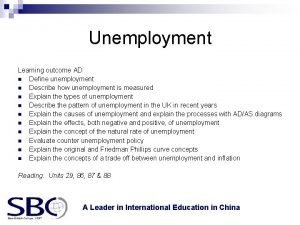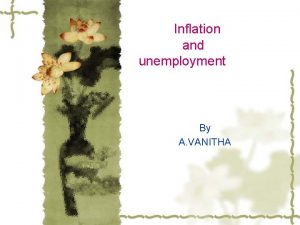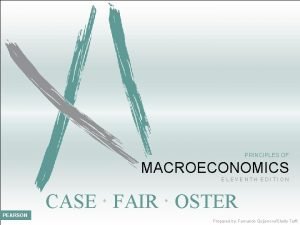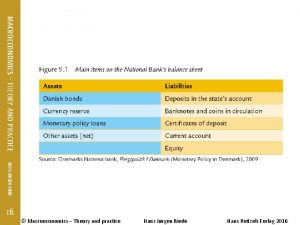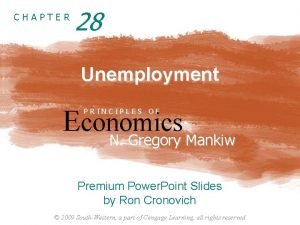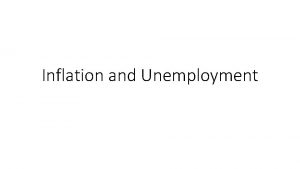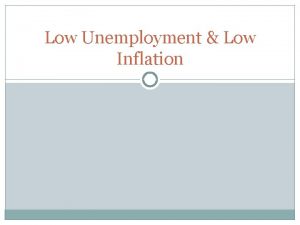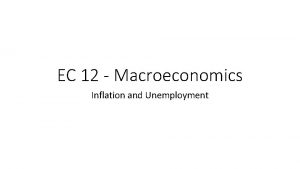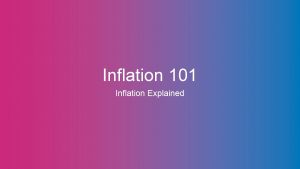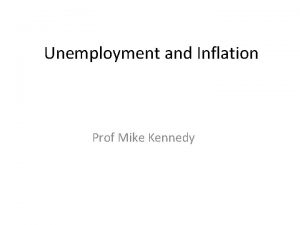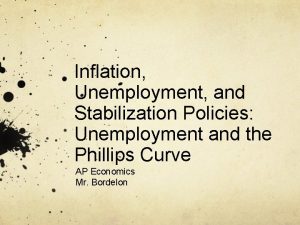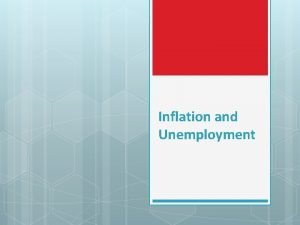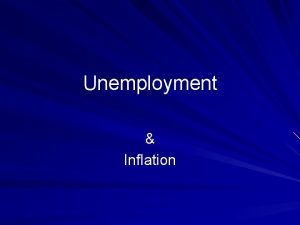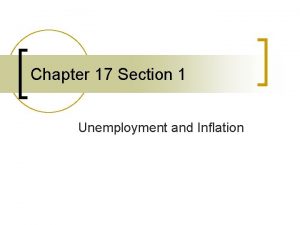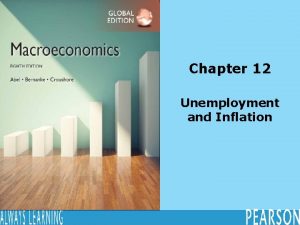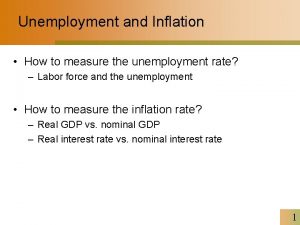Principles of Economics Macroeconomics Inflation Unemployment Output and
















- Slides: 16

Principles of Economics Macroeconomics Inflation, Unemployment, Output, and Prices J. Bradford De. Long U. C. Berkeley

Interest Rates and Spending • Y = μ[c 0 + (G - cy. T) + (cw. W + I + X)(r)]; r: the real interest rate: • r = i (the current interest rate) + E(Δi) (expected change in interest rates) + ρ (the risk premium) - E(π) (expected inflation) • Rule of thumb: in the U. S. today, boost the (risky) real interest rate r by 1%-point: reduces exports by $50 billion/year; reduces household consumption spending by $50 billion/year; and reduces business investment spending by $200 billion/year • The “Liquidity Trap”

Aggregate Supply • Where is the aggregate supply curve? • Full employment • Last year’s prices • Expected inflation

Suppose We Were to Slip a Derivative? • In some ways a better diagram to draw—we aren’t continually having to draw our curves higher and higher on the graph…

The Phillips Curve • When unemployment is high AD is to the left —and we should see inflation less than expected inflation plus supply shocks • When unemployment is low AD is to the right —and we should see inflation less than expected inflation plus supply shocks

The Phillips Curve II • When unemployment rises, inflation tends to fall • A relationship called the “Phillips Curve” • But not something you can count on…

The Phillips Curve III • And what inflation rate corresponds to a given unemployment rate has varied a lot over the past half century…

The Phillips Curve IV • And what inflation rate corresponds to a given unemployment rate has varied a lot over the past half century… • The “new economy” of the 1960 s… • The 1973 oil shock… • Whip Inflation Now! • The Iranian Revolution • The “Great Moderation” • • The Volcker Disinflation • Opportunistic Disinflation • Greenspan Stability • Bernanke Inflation Expectations and supply shocks

What Drives Inflation Expectations? • Last year’s inflation • Economic slack • Jawboning? • What’s just happened to gasoline prices • Oil shocks more generally

Slipping a Derivative • In some ways a better diagram to draw—we aren’t continually having to draw our curves higher and higher on the graph…

Okun’s Law • Production (relative to the fullemployment “potential output” level) • Unemployment (relative to the natural rate) • A 2 -to-1 relationship

Suppose We Were to Substitute Unemployment for Production? • This should move up or down depending on how expected inflation changes

And Suppose We Were Willing to Assume That Inflation Expectations Were Adaptive? • Then we slip another • derivative

How Well Does This Do? • Since 2000 (black) there has been very little change in inflation • In the 1990 s periods of unemployment < 5% see inflation creep up; periods of unemployment > 7% see inflation ebb • In the 1980 s (green) we see substantial deceleration of inflation when unemployment > 7% • The 1970 s (red) are all over the place

Breaks Down in the 1970 s and Post-2009 • In the 1970 s big supply shocks shift expected inflation and disrupt the “adaptive” Phillips Curve • After 2009 inflation does not fall (much) even when unemployment is very high • In between we have: • π = -β(u-u*) + E(π) • π = -β(u-u*) + π-1

Will the “Adaptive” Phillips Curve Come Back? • Who knows? • Supply shocks • Adaptive expectations • Static expectations (expectations “well anchored”) • Inflation lower bound • “Rational” expectations
 Classical unemployment diagram
Classical unemployment diagram Relationship between inflation and unemployment
Relationship between inflation and unemployment Types of unemployments
Types of unemployments Branch of economics
Branch of economics Economics unemployment
Economics unemployment Principles of macroeconomics case fair oster
Principles of macroeconomics case fair oster Economics and business economics maastricht
Economics and business economics maastricht Non mathematical economics
Non mathematical economics Input design
Input design Examples of micro economics
Examples of micro economics Micro macro economics
Micro macro economics New classical and new keynesian macroeconomics
New classical and new keynesian macroeconomics Ap macroeconomics supply and demand analysis
Ap macroeconomics supply and demand analysis Macroeconomics theory and practice
Macroeconomics theory and practice New classical and new keynesian macroeconomics
New classical and new keynesian macroeconomics Principles of economics third edition pdf
Principles of economics third edition pdf Chapter 28 unemployment problems and applications answers
Chapter 28 unemployment problems and applications answers
